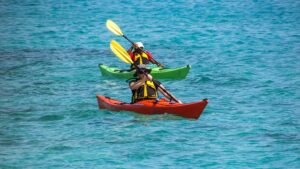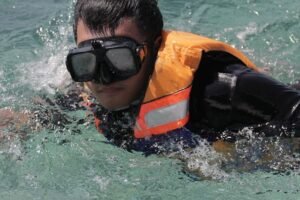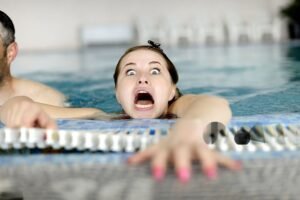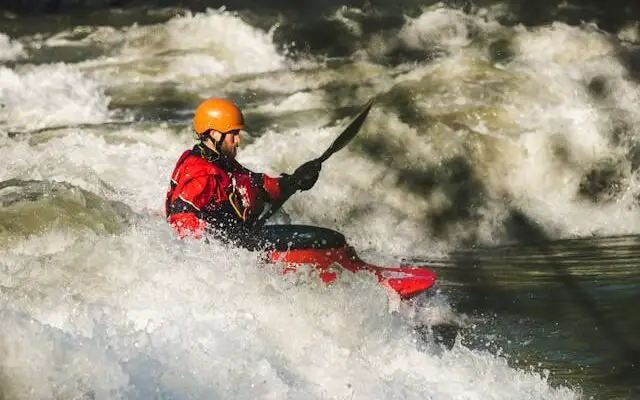Kayaking, a water sport enjoyed by many enthusiasts, offers a unique experience of exploring water bodies while gliding smoothly across the surface.
However, for non-swimmers, the idea of venturing into kayaking may raise concerns about safety and competency in water-related activities. In this article, we’ll delve into the safety aspects of is kayaking safe for non-swimmers, exploring its benefits, precautions, techniques, and equipment necessary to ensure a secure and enjoyable experience.
The majority of people will tell you that kayaking is a universal sport that anyone will be able to do, irrespective of their age, weight, and health condition. The case for them would be what?
Chiefly, kayaking need not be identical to swimming. The most amazing thing about kayaking is that you don’t need to be a good swimmer to paddle and take off- you only need to sit in or on your kayak and paddle. But, since kayaking is a type of watersport, so, I guess the day will come when you fall out of it as well.
That’s why a better question would be, “Can one who cannot swim do kayaking?” It is always a yes. But it is essential to consider some factors to ensure your safety as a non-swimmer despite being able to go kayaking.
Even if you cannot swim you can still kayak however may I offer a few things you should know to have fun while being safe while kayaking.

Can You Kayak If You Can’t Swim?
True, in general, you will not need to know how to swim to kayak. But of course, it would be advantageous to be a sworn enemy as well.
Later on, you’ll be neighbors to the water so watch out, Or else, you’d be getting in a big pot of trouble. Swimming is terrifying. You are scared of drowning the most However, such a situation could be prevented by wearing a life jacket, staying in shallow water, and keeping all safety measures on top.
Is Kayaking Safe for Non-Swimmers?

The danger of being in the water for a non-swimmer, even if you plan on kayaking in a safe area.
As an example, paddling on a placid lake not far from the shore, while doing a group kayaking might not be dangerous. You won’t have any issues climbing out of the water even if you fall in the water because it’s too shallow and we will be there to assist you in case of anything.
For a person who cannot swim, kayaking on the open waters or even in the run of the river could be life-threatening. Likewise, these conditions can be unstable and the risk of a fall increases but it is strongly connected to the situation.
In addition to that, there are some techniques for which you must learn how to fulfill the situation when you have to deal with water, for example, the Eskimo roll.
What we need to be aware of is this: kayaking is like every other water sport with an inherent risk- apart from the fact that it involves drowning. Nevertheless, this hazard can be reduced greatly by putting on a life jacket every time you are out on a water wrestling with waves.
The true figure shows that out of all the fatal boating accidents that were caused by drowning (fatalities being 81%) and were caused by drowning (accounting for 83% of fatalities), a shocking 83% of victims who were not wearing a PFD at the time of the incident.
While we cannot say that using a PFD would have changed the result in each accident, it is obvious from various case studies that using a personal flotation device significantly improves the odds of survival in the water.
Thus, when it comes to maximizing your safety while kayaking as a non-swimmer, being mindful of PFD use at all times should be your priority. This, however, will keep you not sinking if you happen to fall in the water but cannot swim.
Beyond that, there are several other precautions you can take:
- Choose a stable, beginner-friendly kayak to reduce the risk of capsizing
- Paddle in calm, sheltered waters close to the shore
- Avoid paddling alone – always go with a buddy or group
- Take lessons to learn proper technique and safety skills
- Work on getting more comfortable in the water
Do You Need To Know How To Swim To Kayak?
To me, having learned how to swim is one’s safest option. Nonetheless, it does not disqualify”.
As regards the techniques, swimming is not indeed a required skill to go kayaking. What is much more important to mention here is that you should be at ease in the water and know how to swim – although, with the life jacket assistance, you will be saved.
However, you must keep in mind the probability of you jumping into the water at some point or another, bumping the canoe. It’s an incident that just, naturally, emerges with kayaking. Once it takes place (it’s not a question of if), you should make sure that you can maintain composure and get into your sea kayak again, or even stay on the water until help arrives if you are no longer inside the vessel.
That brings me to my next point:
Wear a life jacket.
Coming right out of the bathtub, let’s tell you where it is even if you are an excellent swimmer. But for non-swimmers?
A PFD becomes non-negotiable.
In addition to this, it is also very useful to learn from somebody who can understand better your role as a fellow kayaker who is still on the low end of experience or any component kayaking can be difficult for you as a non-swimmer. Lastly, I consider a paddling partner who is more experienced because he or she can swim, is good at paddling, and can perform a rescue in case of an emergency.
Can You Fall Off a Kayak?
It is likely the most feared outcome if you are using public transport and not an experienced swimmer.
Yes. While kayaking, you become subject to the possibility of falling if you lose your balance, thereby tipping over and getting into the water. However, this probability lies primarily in the water conditions and the kind of kayak you’re going to use.
Your paddle will be more likely to be stable and an accident such as a fall off water is less likely to happen. The risk of falls is not just proportional to rough waters, rather, an unstable kayak is the major issue in the equation. Be prepared to be tossed out of your kayak by suddenly overpowering wind or waves.
You can decrease your probability of losing your kayak by using a kayak from your skill level and where you will paddle.
There is always a risk of getting down from the bike only if you do not protect yourself well. Another important lesson that I learned during kayaking is that there is no hero here, even the most seasoned kayaks go overboard sometimes.
What to Do If You Fall Off
Something as simple as falling off a kayak is already hard to think about, other than getting back onto your kayak is something that comes with its challenges. This is where a deficiency of know-how of swimming might spring up your big trouble if you don’t know how to swim.
Another easily the simplest thing you can do is to restart your kayak.
You can choose the type of kayak that is convenient with the below criteria. It is less difficult to return to a sit-on-top kayak while you crew from a sit-in kayak.
The rollback would be the first thing to do if you are on a kayak that is sit-on-top and in that case, you fall off the kayak. With the hull directly above you use one hand to reach over the side and grab the other side of the kayak. Lean over and pick it up toward you, flip it over. Resident kayaks are ditto with the majority of them having scupper holes to drain out the water in the kayak characteristically.
First of all, when you have the kayak upright grab the side that is farther away from you with one hand and the side on the closest part with the other hand. To complete the roll grasp the kayak’s rim and kick your left leg out to keep it behind you, and with another strong kick, get your head, hand, and shoulders onto the kayak.
Be careful as you bring your upper part and then your seat into your kayak. At last, bring your legs to the kayak.
The sit-onside kayaks are relatively simple to climb in as they are not high and have an open deck. Sitting in a cockpit position kayak again is a little more challenging because they are high and have an enclosed cockpit. Moreover, they have a built-in sump that would require you to remove additional water through a pump.
The easiest way to get in kayak again if you don’t play in the water is with the help of an experienced person as you can see in the video below.
In case you’re neither with a few inches of depth of water around you nor you’re sure you can swim, you’ll be in trouble if you fall off your kayak. This is one of the reasons why keep your distance to kayaking alone. It’s essential to conduct knee and chest-deep water practices and be fine with water.
10 Tips For Kayaking As A Non-Swimmer
Whether you know how to swim or not, there is not much difference in the safety basics of kayaking. I must admit it is not that hard and usually by learning a just handful of fundamental techniques, acquiring appropriate gear, knowing your limits, keeping an eye on the risks, and taking all measures of safety you can be sure to explore this type of outdoor activity.
With that said, here are some essential tips for kayaking as a non-swimmer
1. Always Wear A Personal Flotation Device PDF (And Make Sure It Fits)

You should buckle up with the life jacket which is the most effective way for you as a non-swimmer on kayaking may go astray. I can’t stress this one enough:
With this life jacket, an individual could only survive a situation that would have otherwise had a deadly outcome. So it is not something that is only seen as a nice-to-have, but is a no-brainer must-have piece of kit that you hope or pray you never have to use – but could well save your life one day.
Thus, in addition to that it is not only a matter of personal predilection, but rather it’s a must-have with the concern of being on the big wave out on the ocean.
Just like an idiot, even today, there is no valid reason people cannot put on a life vest when there are a lot of options in shapes, lines, and sizes. In total, let me also emphasize that there are plus-sized clothing lines for the big and tall category of individuals.
To conclude this, I also would recommend you take care of it when you buy it. It has to be reasonable about your shoulder width, and of course, your weight.
2. Never Paddle Alone

As much as I cherish the serenity of a private adventure‚ giving oneself a long and lonely ride through the waters is not a wise decision.
“Numbers from the crowd provide safety”.
That’s a mantra that kayakers should have in their minds at all times and stick with it at any time. And so, when I am the only one in the pool that doesn’t swim.
Having an experienced kayaker who is on your side will help you lose that anxious look. Also, you’ll have someone to walk alongside you while things don’t go the way they are expected.
Besides being an accomplished paddler, whenever I paddle with another paddler, I get a self-assuredness boost that I wouldn’t otherwise receive had I gone solo paddling. That, you could claim, is coming from a former competitive swimmer, – and this is already a good deal of evidence about the importance of kayaking in a group, forgetting about oneself being non-a swimmer.
For instance, you will have some company to let you have a good time.
Therefore, try to hang out with the ones who are already into kayaking because of my own experience, I can assure you they’ll be glad to help you get a bit more daring.
And if you don’t?
Great! There is always an option of becoming a member of the local kayaking club or creating your online community – on kayak forums or Facebook groups for example.
3. Take Kayaking Lessons & Work On The Basics

Besides being an accomplished paddler, whenever I paddle with another paddler, I get a self-assuredness boost that I wouldn’t otherwise receive had I gone solo paddling. That, you could claim, is coming from a former competitive swimmer, – and this is already a good deal of evidence about the importance of kayaking in a group, forgetting about oneself being non-a swimmer.
For instance, you will have some company to let you have a good time.
Therefore, try to hang out with the ones who are already into kayaking because of my own experience, I can assure you they’ll be glad to help you get a bit more daring.
And if you don’t?
4. Pick Your Kayak Wisely – Stability Is Everything
A swimmer or non-swimmer, beginner or expert, making the correct decision can be very tough. This is the case when selecting the right kayak. Therefore, if you are going through such a phase, stay assured that it has hardly anything-or indeed nothing- to do with you directly. And the list of pros and cons I’ve created goes on and on. All that is left is the decision I have to make: period.
Humorously, this has been my job and I’m not left wondering about the next spring/summer ‘yak to buy once the season draws near.
That said, I do have some advice for you:
First, if I were choosing between a sit-on-top and a sit-in yak, I would lean more toward the sit-on-top choice. SOT kayak tends to be simple to operate, so they are popular and not hard for even the greenest beginner kayaker. In addition, being built with an open deck design of a sit-on-top kayak also means that you will not have a problem getting yourself back on board tack to tidal forces.
However, there is also no downside to whether bike hanging new ‘yaks are worth it or not. You won’t have to worry about staying dry because a closed-off deck is going to help you. And a pair of spray skirts is a good idea if you are sailing in the cold time.
Secondly, although you may be a newbie at kayaking or just a non-swimmer, stability is the most important aspect to consider when you are choosing your first kayak. Bigger kayaks are usually more stable vessels and therefore rare to type or capsize. What is more, the stable kayak sit-on-top yak always has the upper hand over sit-inside ones in this matter.
The t breadth of most recreational kayaks ranges from around 30 to 34 inches, with the length being 9 to 12 feet. Thus, the width-length ratio corresponds to enough stability for most kayakers.
By the way, if you are a little reluctant to ride alone, you can always team up with somebody and go on a tandem kayak. That way, you’ll additionally have a party mate with you on every occasion and that should be quite an advantage – it will certainly reduce your level of anxiety and regard the whole adventure as a very pleasant one.
5. Consider Fitting Your Kayak With Outriggers
You’ve possibly done the riding training wheels during your bike riding lessons. Yes, I confess, it’s not even the coolest analogy I’ve ever thought of; nevertheless technically, outriggers play for kayaking the greenhorn leveling life like a training wheel does on a bicycle.
The goal of generating outriggers is to increase the stability and, consequently, the buoyant capacity of your watercraft. In this regard, they are exactly as its nomenclature implies: they are to combat the kayak’s instability.
Buying these paddles may not be needed if you are aiming for performance and speed because even without them, they are not tippy.
On the one hand, the stability provided by something like exercise bands can be a game-changer for non-swimmers as they learn the ropes of kayaking, and on the other, it may just be the difference between life and death. Fearing sea sickness is one of the most significant concerns on the minds of a novice rider. However, a ‘yak that’s virtually impossible to capsize will leave you feeling a lot more at ease.
The thing is that even if your pocket is tight, you don’t need to worry. If you are up to taking a big financial risk and are confident in your DIY skills then you get to make a set of stabilizers yourself.
6. Try To Conquer Your Fear Of The Water

“If you want to defeat fear, you should learn to become fear.”
I’m cringing a bit hoping that there surely be a few people who get this reference. Moreover, such line is the sentence from that Batman movie.
All jokes aside, though:
In my opinion, overcoming the fear that you might have the water – it doesn’t necessarily matter the root causes of this phobia – is imperative if you are planning on entering the kayaking kingdom.
You’re never going to find yourself having fun on the water even figure in a ‘yak if you don’t get over that panic you feel whenever you first start paddling.
What follows is a confession– although you probably know better, the overwhelming fear of deep and open water is pretty common. If you will, it is one of the most frequent phobias in the United States, as over two-thirds of the country’s population claim so, and 46% fear even stepping into the deep end of the swimming pool. And, to add to it, 55% of people aged 15 and older reportedly cannot swim unassisted.
So the bottom line is that; you’re not here on your own.
However, going kayaking despite your fear can be an appealing adventure. If fear is serious on your list, you can also begin to discuss it with the kayaking instructor first.
One, after all, if you are not experienced at the sport, you are likely to spend your entire time fretting about what might happen, even if there is no reason for you to be concerned in this way – and, if so, this gets to spoil the experience for you. A second consideration that I would want to bring up is that tearing up will only get you bubbled up and acting in panic irrationally, at the end this may impact other paddlers if the happens preciously to you.
Here’s what might help you overcome your fear of the water:
- Start small; the shallow end of a swimming pool will be enough to help you get used to being in the water
- Learn how to float on your back (with the support of a PFD)
- Get comfortable with being submerged
- Learn how to hold your breath underwater and blow bubbles out of your nose
7. Pick A Suitable Location

There’s one piece of advice that seasoned paddlers and instructors often share with beginners – and I feel like it would apply here, too: There’s one piece of advice that seasoned paddlers and instructors often share with beginners – and I feel like it would apply here, too:
Always paddle exclusively as far as you can reach swimming back.
As an utter beginner, you mustn’t go too far from the shore during your kayaking trips. Another important thing is choosing a corresponding location where you can practice skills that match your overall experience and level of proficiency at the same time.
It’s best to route you stay on flat and shallow water, in lakes, slow-flowing rivers, or sheltered bays, but only that sometimes the conditions permit it. Doing so will enable you to avoid getting in the water by all means but if somehow you fall in, then you will be in a good position of helping and getting back on your canoe.
So, that way instead of being entirely in the water you are only at the risk of skipping the Class IV whitewater rapids – and, obviously being in something more non-swimmer-friendly. Don’t do anything deeper, faster, or wide open. That’s a bad sign usually. Use our AI to write for you about space exploration and astronomy.
Swimming might be the hardest when an individual touches the discomfort zone of water – either out of fear or phobia. Or if it seems to get windy or there will be a lot of current during your trip then everything is not safe, postpone or change the location.
And likewise recognize how fast surface conditions and the weather can change, therefore being focused on the forecasts before you go out.
Of course, precautions are always better than causing a tragedy later, aren’t they?
8. Don’t Be Tempted To Use A Leash
To be sure how to apply the leash is also understandable, usually safety boats for paddle boarders use the leash attached to their boards.
It may seem to you that paddling the same creek just as you would with your kayak is something great – well, in principle, at the very least. But in practice? To be honest, it is a very dangerous thing to do – especially swimming a kayak which is sitting down.
Think about it:
What if the case is filled with water accidentally and you are unable to free yourself off? As a leash means you’re like a line attached to a sinking boat that takes no heed of you and drags you deeper every step you take, accordingly.
Not pretty a horror story indeed, isn’t it?
On the other side, a situation where you may find yourself stuck in a water obstacle which can be challenging to get out of as you will be dragging the boat with you because you are being stuck to the boat.
It would make you even more unfit for the task though you’ve been in the water most of your life. However, if one is not a swimmer, this terminology is metaphorical, as, actually in such circumstances, one is likely to be in the danger of being drowned.
The only acceptable function of a leash in this activity is to tie your paddle to your kayak so it doesn’t drift out of range. Without that burden, you won’t have anything to pamper about with a swim accident which will let you concentrate on how to get back on the boat.
9. Paddle in Calm, Sheltered Water
If you’re a non-swimmer then the ocean, rivers with fast waters, and large lakes may not be the best choice for you. Looking at your kayaking adventures from time to time, stick to the waters that are tranquil and have shallow waters of only a few inches. This becomes crucial if you are only practicing the skill by yourself.
Assuming there’s no rough water or anything else that might distract me, I would be a very precautious and careful paddler and would stay on my kayak even during strong waves and wind. Being a novice swimmer you surely prefer to stay away from water as much as possible, however, if you fall in you may benefit from remaining in the place of your comfort zone as it would prevent you from panicking.
You will be more freely swimming by the end of it, enjoying the ambiance of the scenery as you kayak.
A stable kayak, in this context, shows much less chance of ending up in water. Such amazing and fantastic will be your experience with the fear that you don’t know how to swim.
10. Get a Wide and Stable Kayak

The stability of a kayak may not be determined by the type of cockpit, either sit-in or sit-on-top: it greatly depends on the beam and the hull form. Generally, the wider the kayak, the more stable it is.
By far, the majority of recreational kayaks will work for a beginner as they are usually 30 inches or wider. Among other types of kayak fishing are that of the most stable as narrow as 40 inches. You can stabilize on your feet and avoid seeing twirls or spins.
Another feature to be alluded to is the type of the hull since it will be a big deal on stability. If non-swimmer is applicable, then basically you can paddle with a hard shell kayak that is generally designed with a flat hull considering that the water depth is shallow. Sitting in Flat hulls is considered as the most stable position by the boats researchers and comparatively, they are also easier to control.
Is Kayaking Safe For Non-Swimmers: A Quick Summary
Trapping a kayak is streamlined not only for people who possess the skill and ability to swim but anyone can enjoy some time on the water. Kayaking for non-swimmers can be perfectly safe and fun – so long as you can get over your fear of the water and take the necessary precautions:
- Always wear a properly fitted PFD
- Paddle with an experienced kayaker (who knows how to swim)
- Take a kayak lesson and learn the basics of paddling
- Pick a kayak that’s stable and beginner-friendly
- Choose a suitable location (relatively shallow and calm water)
- Fit your kayak with outriggers for additional stability and buoyancy
Frequently Asked Questions About Kayaking for Non-Swimmers
- Do You Need to Know Swimming to Kayak?
- No, you don’t need to know how to swim to kayak, but it is advisable if you want to try and limit the dangers. Being a strong swimmer has its advantages because kayaking is a water sport.
- Is It Easy to Tip Over a Kayak?
- No, it’s not easy to tip over a kayak. Kayaks may be small but they are quite stable as long as you use the right kayak for the right water condition. For example, recreational kayaks are designed for flat-water paddling. So it will be hard to tip one when paddling a calm lake.
- Is Kayaking Safe for Non-Swimmers?
- Yes, kayaking is safe for non-swimmers, provided they adhere to safety precautions. If you don’t know how to swim you have to be extra careful in the water. Avoid choppy water and other rough conditions. Instead, stick to shallow, glassy water where you’ll likely be safe even if you fall in.
- Is Tandem Kayaking Safe If You Can’t Swim?
- Yes, a tandem kayak is safe as long as the other person is an experienced kayaker and a strong swimmer.
- Can You Kayak with a Child That Can’t Swim?
- Yes, you can but only if you can swim. When you bring your child you’ll be responsible for more than just yourself. So you should make sure that you’re a good swimmer and are confident in your kayaking skills.
- Are Swimmers Good at Kayaking?
- Being a good swimmer doesn’t automatically make you good at kayaking. But it goes a long way. You’ll have an easier time learning all the essential kayaking techniques because you’re already comfortable in and around the water.





Very nice post. I just stumbled upon your weblog and wanted to mention that I’ve really loved surfing around your weblog posts. After all I will be subscribing on your rss feed and I am hoping you write once more soon!
Hi there, You’ve done a great job. I will definitely digg it and in my opinion suggest to my friends. I am confident they’ll be benefited from this web site.
hello!,I like your writing so a lot! percentage we be in contact more approximately your post on AOL? I need a specialist on this house to unravel my problem. Maybe that is you! Taking a look forward to peer you.